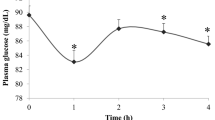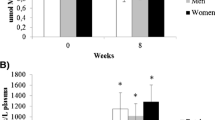Summary
Background: Green tea contains polyphenolic catechins which can act as antioxidants and thus decrease the risk for cardiovascular diseases.
Aim of the study: To investigate whether green tea extract differs from placebo in its effects on markers of antioxidant status, lipid peroxidation, nitric oxide production, thromboxane production, and blood coagulation during a controlled high linoleic acid diet in healthy subjects.
Methods: Twenty healthy non-smoking females (23–50 years) participated in a 4-week controlled intervention study. The experimental diet was rich in linoleic acid (9 en%) and contained fat, protein and carbohydrates: 27, 14, and 59 en%, respectively. In addition, the subjects ingested encapsulated green tea extract (3 g/d) or placebo mixture in a double-blind manner. Fasting blood samples and five 24-hour urines were collected before and at the end of the 4-week experimental period. Same samples were received from 10 control subjects.
Results: Green tea extract significantly decreased plasma malondialdehyde (MDA) concentration in comparison with the placebo treatment. The treatments did not differ in serum lipids, indicators of antioxidant status, urinary 8-iso-prostaglandin F2α, 2,3-dinor-thromboxane B2, nitric oxide metabolites or coagulation indicators.
Conclusions: We conclude that an amount of green tea extract which corresponds to 10 cups of tea per day for 4 weeks does not have specific effects on several indicators related to risk of cardiovascular diseases in comparison with placebo treatment. The relatively small but significant decrease in lipid peroxidation indicated by decreased plasma MDA was not associated with changes in markers of oxidative stress (urinary 8-iso-prostaglandin F2α and blood oxidized glutathione) or hemostasis.
Similar content being viewed by others
Author information
Authors and Affiliations
Additional information
Received: 8 January 1999, Accepted: 12 April 1999
Rights and permissions
About this article
Cite this article
Freese, R., Basu, S., Hietanen, E. et al. Green tea extract decreases plasma malondialdehyde concentration but does not affect other indicators of oxidative stress, nitric oxide production, or hemostatic factors during a high-linoleic acid diet in healthy females. Eur J Nutr 38, 149–157 (1999). https://doi.org/10.1007/s003940050056
Issue Date:
DOI: https://doi.org/10.1007/s003940050056




